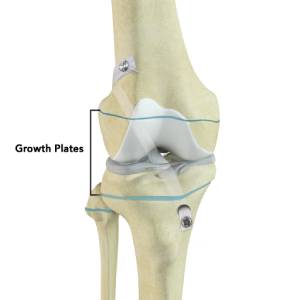Transphyseal Surgery
Transphyseal ACL Reconstruction

Surgery may be recommended to reconstruct a torn anterior cruciate ligament (ACL). It usually involves the use of a soft-tissue graft, which is passed through small tunnels (generally 7-10 mm) drilled into the very top of the shinbone (tibia) and the very bottom of the thighbone (femur) at the level of the knee joint. In a child or adolescent, a transphyseal ACL reconstruction may be performed where the tunnels pass through the growth plate or physes (area near the end of a long bone where growth is still occurring). Injury to this area could potentially affect growth and result in differences between the lengths of the bones between each leg and/or differences in the angle at which the bones are growing between each leg. An appropriate surgical technique is used to minimize these effects with multiple studies demonstrating its safety, particularly in the child at or after puberty. Transphyseal ACL reconstruction allows anatomic reconstruction of the ACL at its natural location, similar to surgery performed in adults.
Indications for Transphyseal Surgery
An orthopedic surgeon may recommend ACL reconstruction via transphyseal surgery for active children and adolescents who are involved in sports or recreational activities. Because knee instability due to an ACL tear can lead to meniscal and cartilage injuries and early onset of arthritis, ACL reconstruction is designed not only to allow patients to have improved knee stability for cutting and pivoting activities, like sports, but also as an act of joint preservation, to prevent other injuries to structures in the knee joint.
Transphyseal surgery is preferred for children with older children who have reached or are beginning puberty. The risk of growth problems after transphyseal reconstruction in very small when performed properly. Utilizing x-ray guidance (called fluoroscopy) during surgery can increase the safety by ensuring proper tunnel position. The growth remaining from the femur and tibia at this stage of maturity is less than a pre-pubertal child. In the younger child, less evidence of the rate of growth problems exists but may also be safe if performed effectively. Small changes in growth that do not affect function or are visually apparent are likely more common than previously realized.
Benefits of Transphyseal Surgery
Benefits of transphyseal surgery include:
- Effective treatment with low rates of complications
- Improved knee stability
- Allows return to sports following adequate rehabilitation
Transphyseal surgery has demonstrated excellent functional results in children and adolescents with low rates of significant growth disturbances.
How to Prepare for Transphyseal Surgery
Your doctor may recommend using a brace to provide improved stability while the knee recovers from the initial injury and possibly allow healing of other knee ligaments before surgery is performed. You may need to undergo physical therapy to improve range of motion and allow knee swelling to go down. If the knee is stiff or swollen at the time of surgery, restoring range of motion may be difficult after the surgery, which could affect the success of the procedure and increase the rate of additional surgery. You may be given specific instructions on ‘do’s’ and ‘don’ts’ before and on the day of your surgery. Instructions may include details on food intake, medication, etc.
How Transphyseal Surgery Works
Hamstring tendons on the inner side of the knee (inner thigh muscle) are mostly used as a graft in transphyseal ACL reconstruction surgery. Tendons are harvested and may be bundled together to create the ACL graft. Instead of the hamstring tendons, an orthopedic surgeon may opt to use the quadriceps tendon ACL graft. Ongoing research in the PLUTO group will better define the outcomes of hamstring vs. quadriceps tendon ACL reconstruction.
- Small incisions are made over the knee to insert an arthroscope and instruments.
- The torn or injured ACL is removed
- Tunnels are drilled through the bones and oriented to minimize injury as they pass through the growth plates (making them small and as vertical and central as possible)
- Drilling is performed slowly, which also minimizes injury to the growth plate
- The graft is passed through the tunnels
- The graft is fixed and secured with a metal button and screw (most commonly) away from the growth plate
Risks Associated with the Procedure
Transphyseal ACL reconstruction surgery carries a few risks, some of which are correctible.
The risks include:
- Stiffness due to scar tissue formation which restricts joint movement (called arthrofibrosis)
- Growth disturbance due to damage to the physis
- Including angular deformity, shortening , or overgrowth
- Traumatic graft disruption (ACL re-tear)
- Post-operative knee instability
Recovery after Transphyseal Surgery
Rehabilitation is very important to help you return to your regular activities and sports. You will work with a physical therapist to help you safely achieve these goals. Therapy is initiated within 1-2 weeks following surgery and will focus on improving range of motion and strength. Regaining knee range of motion is critical in the first 6 weeks after surgery. You will have to adhere to certain activity limitations initially. As you progress with therapy, the focus shifts towards improving balance and neuromuscular control. At 3 months, you may be able to jog, and agility exercises and sport-specific training can safely be introduced after 6 months. Special training to optimize movement patterns during athletics can help prevent future knee injuries, such as re-tear of the ACL graft.
